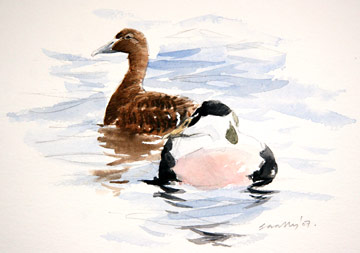Eider (Somateria mollissima)

Eiders © Ray Scally
Happily, Eiders are no longer threatened with extinction, as they were in the 18th century, by collection of their down for use as human bedding. The birds feed in relatively shallow coastal waters, up to about 3 m deep, diving to take molluscs and crustaceans from the sea-bed, especially Common Mussels Mytilus edulis and other bivalves, plus periwinkles, whelks, starfish, crabs, sea urchins and other slow-moving invertebrates. Eiders pair during the winter, the male taking responsibility for watching for predators or competitors whilst his mate feeds and builds up the body reserves necessary for a successful breeding season; females which pair after midwinter usually lay late or fail to breed (BTO Winter Atlas).
This sea duck has become more common in the county in the last fifty years. Coward (1910) knew of only one on the coast, seen by Oldham in the lea of the sea-wall at Leasowe on the bitterly cold day of 31 December 1905, with a bizarre flurry of three inland records in 1894 and 1895, at Saighton, near Nantwich and at Aldford. Bell (1962) could trace no further records until 1939, when it started to become more frequent, and was found roughly every other year from 1951 to 1960. Bell (1967) and the county bird reports show that from 1960 Eiders have become almost annual at the coast, most often near Hilbre, with less frequent records from anywhere along the north Wirral. Birds farther up the Dee estuary, such as the female at Parkgate on 11 January 2005, mapped in this Atlas, are as rare as inland records, of which the last was in 1999.
There is no direct proof from ringed birds, but it is tempting to link the rise in sightings in Wirral waters to the foundation of the breeding colony on Walney Island, Cumbria, the most southerly breeding site on the west coast of Britain, which was colonised in 1949, and has been occupied ever since.
The Atlas map shows their typical winter distribution. The only double-figure counts were 14 off Hilbre on 6 December 2006, with 10 off Hoylake Shore in winter 2004/ 05.
Sponsored by Geoff Blamire

